
Austrian and German Nuclear Societies’ Young Generation Networks visit Chernobyl
By Eileen Radde, Austrian Nuclear Society
A visit to the Chernobyl site where, in 1986, the terrible nuclear accident occurred is a challenging but interesting project for nuclear engineers. Part of the German Nuclear Society’s Young Generation network (GYG) had already visited the site in 2010. The Austrian Nuclear Society Young Generation network (AYG) was also trying to arrange a visit to the Ukraine.
Together with Markus Zink, Eileen Radde planned and organised not only the logistics of the visit but also the 4-day programme. Denys Zenyuk was the organiser from the Ukrainian side and we would once again like to thank him for his invaluable help.
The excursion started on Thursday, 17 May, when the tour party flew from Frankfurt, Munich, and Düsseldorf, via Vienna, to Kiev. The afternoon was free for people to get a first impression of Kiev. In the evening Denys invited us to a concert in the Art44 club in the centre. (Photo 1)

Photo 1: Concert at the ArtClub 44
On Friday morning the bus for Chernobyl picked us up at 7:45. Under normal conditions, the journey to the site takes about 2 hours. Our first appointment was scheduled for 10:00. However, 20km before we reached the zone our bus stopped unexpectedly; it had broken down. Our bus driver tried to repair the bus, and we eventually managed to continue for another 300m. Once again it was repaired. In the meantime, we had already organised a replacement, which was a good thing because our bus only made it another 5km (Photo 2).

Photo 2: First breakdown of our bus |

Photo 3: First dose measurement
|
We used all these unplanned breaks to take our first radiation dose measurements, samples and spectra. (Photo 3). After a delay of two and a half hours we finally arrived at the Chernobyl zone. We had to cancel the visit to the spent fuel facility and the control room of unit number 3, but lunch was saved.
On the way to Unit 4 of the Chernobyl NPP we measured a dose rate increase as we progressed along the road, which we couldn’t explain initially. After more detailed discussions we figured out that because of the construction works for the shelter project that were taking place trucks were moving out of the construction area without any prior decontamination. It would, therefore, have been useful to dust protect the roads, cover the road with bitumen or spray the trucks before leaving the zone.
The measurements were taken using an ATOMTEX Backpack system, and analysed with Google Earth. The values are in µSv/h, and the increase as we approached the construction site was clearly visible from 0.5µSv/h up to 1 – 1.3µSv/h. All measurements were taken inside the bus and can be seen in Photo 4.
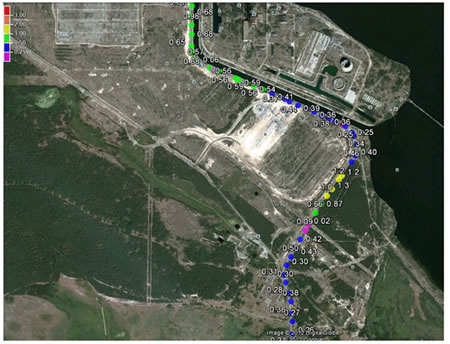
Photo 3: Increase in dose rate
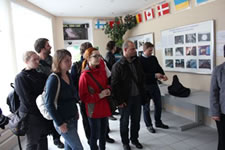
Photo 4: Inside the shelter house
|
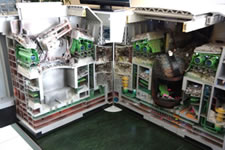
Photo 5: Model of reactor
|
The first part of the visit inside the zone was to the shelter hall, where all information about the new shelter project is provided. We were informed about the current status of the project, why the new shelter is necessary and which parties are contributing to the project.
The shelter hall is directly opposite to Chernobyl Unit No. 4, but due to security issues we were not allowed to take any photos.

Photo 6: Our group
The group picture in front of Chernobyl Unit No. 4 (see above) was a must, before we were driven off to have lunch.

Photo 8: Reminders of the past
|

Photo 9: Palace of culture
|
After lunch we were taken to Prypiat, were we walked around in the deserted city, from the main square to the big wheel and the Palace of Culture. We discovered remains left behind by the departing inhabitants, even though many things had been taken or destroyed. Prypiat left a big impression on all of us. It sometimes seemed like time had stood still for 26 years.
As we were 2 hours behind schedule we left Prypiat at 16.00. The busses back to Kiev should have been waiting for us, but they were also 2 hours late. While waiting for the bus we were able to feed an enormous catfish from the bridge.
In the evening we had a typical Ukrainian dinner with traditional drinks.

Photo 10: Catfish
|
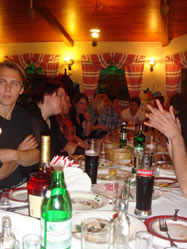
Photo 11: Dinner in Kiev
|

Photo 7: Chernobyl Museum
|
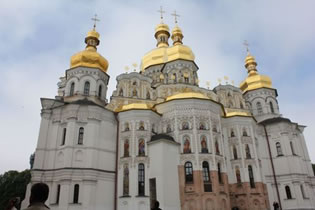
Photo 8: Lavra cave monastery
|
Saturday was dedicated to sightseeing in Kiev. Denys had arranged, together with his college, a visit to the famous Lavra cave monastery. It is one of the oldest monasteries in the Russian-Orthodox church and is beautifully located on the west bank of the Dnieper river.
Afterwards we visited the Chernobyl museum, which has a special display dedicated to a 25 years memorial to the accident and a section on the recent Fukushima accident. It is interesting to note that many of the anti–nuclear posters there were printed in Austria. The exhibition was prepared with an eye for detail. Foreign visitors may encounter difficulties walking through the museum as the descriptions are all in Russian, but the museum provides audio guides in 3 languages, which were very helpful.
After a quick lunch we rented a boat for a tour on the Dnieper river, which is an impressive way to see Kiev and is highly recommended.
Photos 9 + 14: Boat Tour
After bidding farewell to our hosts and spending an evening watching a football match, we left Kiev on the Sunday. It was a nice and technically interesting tour, despite a few problems encountered along the way. We all enjoyed the Ukrainian atmosphere, hospitality and style, and we hope that some of us will return one day! Thanks again to our Ukrainian hosts!
© Eileen Radde, 2012
|

